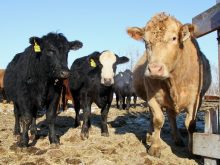Living conditions for retired horses vary widely and can be inhumane but they still need appropriate care
SASKATOON — At more than 20 years old, senior horses come with joys and challenges.
Senior horses in good health can still be ridden, keep younger horses company and be used in lessons or therapeutic riding programs.
Dr. Valentina Ragno, an internal medicine specialist at the Western College of Veterinary Medicine, said owners of senior horses should be mindful of several potential issues.
Ragno said pituitary pars intermedia dysfunction (PPID), formerly called equine Cushing’s disease, is an endocrine disease that can affect several bodily functions. It affects the horse’s pituitary gland and releases excessive amounts of a hormone, which causes the problems.
Read Also

Huge Black Sea flax crop to provide stiff competition
Russia and Kazakhstan harvested huge flax crops and will be providing stiff competition in China and the EU.
According to Ragno, about one in five horses older than 15 years develops PPID. It is found in about one in three horses older than 30.
Common signs of PPID include a long scraggly coat, delayed shedding in the spring, loss of muscle mass (particularly along the topline) and a rounded belly. Behaviour changes can include the horse’s lack of energy and less willingness to perform.
Horses with PPID are immune suppressed, which means they can also develop chronic problems like thrush (a smelly foot infection), sinus infections and recurrent corneal ulcers. Daily pergolide pills, sold under the brand name Prascend, are given to horses to treat PPID.
“If it’s not treated, PPID can leave horses looking older than they are. While medication doesn’t cure PPID, it makes the disease more manageable. The horse can often be kept in work if there are no other serious health issues,” said Ragno.
For owners working with a veterinarian, Boehringer Ingelheim Animal Health Canada offers free PPID testing until Oct. 31. Prairie Diagnostic Services in Saskatoon also runs the test in-house year-round.
Equine metabolic syndrome and laminitis (often referred to as founder) are other potential issues in senior horses. A horse with EMS is likely to develop laminitis unless it is carefully managed. EMS signs can start much earlier in life but can compound other senior horse problems.
Ragno described EMS as similar to a pre-diabetic state in humans, with trouble regulating insulin. Spring and fall grass can have particularly unpredictable sugar content.
Laminitis is an inflammation of the sensitive laminae of the foot. It can be very painful for the horse. If caught early, laminitis can be managed with boots, farrier care and diet. In severe cases of chronic laminitis, euthanasia may be necessary.
“Historically, ponies and donkeys have the genetics to live and thrive in low nutrition environments. As a result, they became thrifty and are able to extract as many nutrients as they can from the food they have access to. Today, ponies often get grain, treats and access to lush grass pastures, often with minimal exercise. It’s way too much for them,” she said.
Other horse breeds with characteristics similar to ponies are likely to develop EMS, particularly breeds with cresty necks.
Owners of senior horses must also keep end-of-life care in mind and make informed choices on euthanasia. Western Canadian horse owners often make these decisions in the fall because of harsh winters.
“Owners choose to let their horse enjoy one last good summer before there is a risk of the senior horse slipping, falling on ice or losing too much weight during the winter. With the high price of hay, financial concerns can also be a consideration for some owners,” said Ragno.
Selling, or re-homing, a senior horse can seem like an ideal solution. Unfortunately, this means the former owner cannot guarantee the horse’s future treatment. Living conditions for so-called “pasture pets” can vary widely and can be inhumane. Retired horses need an appropriate diet, shelter, and access to fresh water, as well as foot and dental care.
Modern methods of equine euthanasia begin with sedating the horse. Using a firearm is legal when carried out by an experienced person.
Chemical euthanasia by a veterinarian involves administering intravenous pentobarbital, potassium chloride or intrathecal (spinal) lidocaine. Some owners like to bury their beloved horse on-farm for sentimental and practical reasons. Pentobarbital cannot be used in a field euthanasia scenario because it is toxic to scavenger animals.
It is important to consider whether burial space needs to be prepared on-farm before the winter and before the ground freezes.
Ragno said if the horse’s body is donated to the WCVM for teaching and research, a necropsy can be performed at no cost. Euthanasia and handling fees are still the owner’s responsibility.
“Overall, equine euthanasia is a bit tricky because in Canada horses fall between pets and production animals. It is the owner’s decision. Questions to ask include — is the horse in pain? Can the horse still move around and reach food and water easily? Does the vet have to come out frequently for emergencies? Can the horse still socialize with pasture mates and have a good quality of life?”
Whatever the reason behind a decision to euthanize a senior horse, owners may experience grief and loss. It may be helpful to access support. Clients of the WCVM in Saskatoon can access its Veterinary Social Work Program for this support.

















